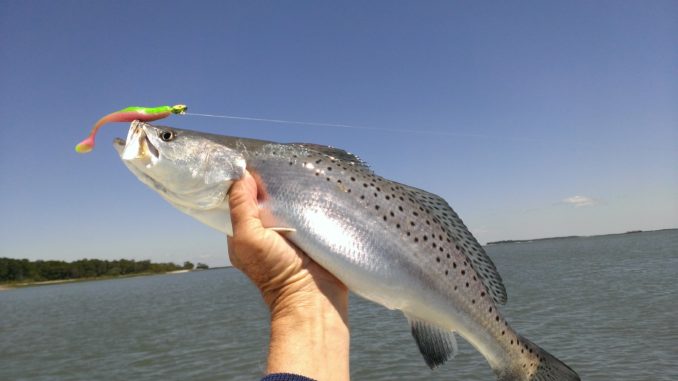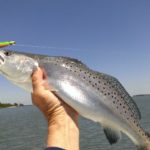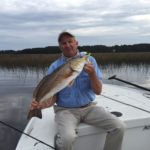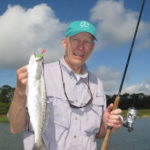
Necessity was the mother of invention 20 years ago when inshore fishing’s hottest color debuted; it’s still catching redfish and speckled trout in South Carolina’s Lowcountry as it did way back when.
Leadhead jigs with soft-plastic trailers probably fool more redfish and speckled trout in the waters of South Carolina’s Lowcountry than all other artificial lures combined. Throw one out and reel it back; what could be more simple? Of course, there is more to catching fish, but if you can find them and get a jig-and-trailer into their midst, you will catch fish.
In the late 1980s, a soft-plastic stickbait from Lunker City called the Slug-Go, burst onto the saltwater scene and became popular for fishing the shallows. Other manufacturers soon began adapting their freshwater, soft-plastic bass lures for saltwater. Robin Shiver, owner of Bass Assassin Lures in Mayo, Fla., tweaked his popular 5-inch, split-tailed shad, making it shorter, plumper and giving it a paddletail. Thus was born the Salt Water Assassin Sea Shad, destined to be a huge success.
To make his new bait more successful, Shiver wanted a marketing hook to catch fishermen, a unique color combination — not the common white baits with pink tails — and he wanted a unique name. At the time, MirrOlure was selling its hard baits in a color called “Texas Chicken”, that was a combination of pink, silver and yellow. He figured out how to make a two-color, soft-plastic lure where the colors did not bleed together, and his creation emerged in 1996 as pink over chartreuse with silver flakes. He named it the “Electric Chicken.”
Today, soft-plastic baits come in hundreds of colors and styles, some scent impregnated like Gulp, some with integrated jigheads like D.O.A., but the original Sea Shad, according to Shiver, remains the industry’s No. 1 trailer, with the Electric Chicken color still leading his collection after all these years. Thread one onto a strong, ¼-ounce jighead, and you’re ready to catch fish.
To effectively cast a ¼-ounce jighead and trailer, a very good setup would be a medium-action, 6½- to 7-foot spinning rod with an open-faced 2500 series spinning reel. Some anglers spool on 10- or 12-pound monofilament, but many experts have switched to 20-pound braided line, which is as thin as 6-pound monofilament, so they can make longer casts.
Fished slowly with a bouncing action, a jighead and plastic trailer imitates a mud minnow, crab or shrimp. Retrieved more quickly, it looks like any baitfish fleeing from a predator.
October through Thanksgiving is the absolute best time in South Carolina’s Lowcountry for catching both redfish and trout. With the water temperature falling, both are feeding aggressively in shallow water throughout the day. Most of the times, you will find trout in slightly deeper water — 3 to 6 feet — than you find redfish. During the middle and higher portions of the tide, both species congregate along grass edges, oyster bars and creek mouths as the changing tide moves water on, off and across these structures. Drifting along a shoreline, casting to grass pockets, oyster edges and points and immediately retrieving the lure back to the boat is a good technique. A bow-mounted trolling motor is handy to keep the boat a short cast from the shoreline. You can also effectively troll an Electric Chicken-colored bait along shorelines if you don’t enjoy casting.
As the tide drops, focus on redfish schools on low-water sand flats. Sight-casting is the name of the game, so look for signs of schools. Nervous water is what guides call it when redfish schools signal their location. Sometimes it is subtle, but often, it’s very obvious that fish are chasing food.
When you find a school, casting to the edge and well beyond the fish and reeling the lure back at a constant slow speed works well. The other option is “drop-and-wait” — you cast several feet in front of the school and let the lure sit on the bottom until the fish reach it. A little jigging action when the fish swim near will get you hooked up. With a lead jighead, you must set the hook aggressively as soon as you feel the bite.
In the old days, a bucktail jig was considered the most-versatile lure. Today, if you had to choose one lure to catch fish anywhere in the world, the best choice would probably be a jighead with a soft-plastic trailer — especially in Electric Chicken. In our Lowcountry shallows, it will catch all our gamefish.
DESTINATION INFORMATION
HOW TO GET THERE — Anglers working the waters of the Broad River and surrounding areas often use the excellent landing on SC 170 at the Chechessee River Bridge, midway between Bluffton and Beaufort, or the landing below the Broad River Bridge. Beaufort River anglers can put in at the Sands Landing near downtown Port Royal. The landing at the foot of the Fripp Island Bridge gives access to the outer islands. Many other free public landing options are available.
WHEN TO GO — October through Thanksgiving is absolutely the best time of the year for redfish and trout in South Carolina’s Lowcountry. Reds are easiest at low tides while trout are best fished on the rising and falling tides.
FISHING INFO/GUIDES — Capt. Tuck Scott, 843-271-5406; Capt. Owen Plair, 843-524-5250; Capt. Doug Gertis, 843-521-9896; Capt. Dan Utley, 843-368-2126; Capt. Jack Brown, 843-838-9369; Capt. Richard Sykes, 843-524-5250; Bay Street Outfitters, Beaufort, 843-524-5250.; Beaufort Boat & Dock Supply, Port Royal, 843-986-0552. See also Guides and Charters in Classifieds
ACCOMMODATIONS — Beaufort Area Chamber of Commerce, 843-986-5400, www.beaufortchamber.org.
MAPS — Top Spot Weatherproof Map N233, is available from local tackle shops. Waterproof Charts, Inc, Chart 93F, Hilton Head/Beaufort, 800-423-9026, www.waterproofcharts.com.




Be the first to comment